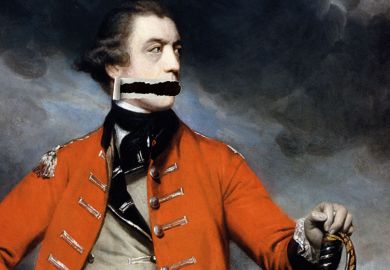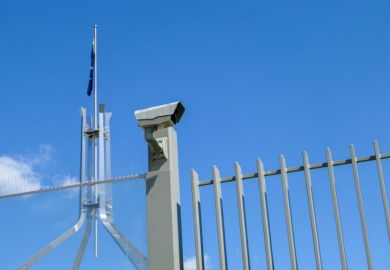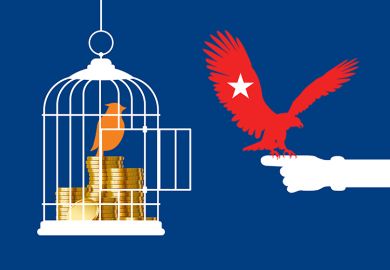Doane University in Nebraska shuttered a library exhibit and put a librarian on leave over historical photos of students in blackface. The university says the images ran counter to its values and, as presented, served no educational purpose. Some of the librarian’s faculty supporters disagree and say that Doane interfered in a learning moment, albeit a painful one, that their colleague was already working to right.
“Were some of our students genuinely offended or hurt by the library display? Yes,” said Brian Pauwels, associate professor of psychology at Doane and vice-president of the campus’ American Association of University Professors advocacy chapter. “Was suspending the librarian in response to that hurt heavy-handed and in violation of the academic freedom that is necessary to do her difficult job every day?”
Dr Pauwels continued: “Can’t the answer to both questions be ‘yes’? Because lots of people want us to pick one or the other. These are values that are hard to define, and now they’re colliding with one another.”
Other academics think Doane made the right call.
Mark Orsag, professor of history, said this was “primarily a common-sense and respect issue and not an academic freedom issue”. Because the photos in the display were not “contextualised at all”, he said, there “was really no education taking place”.
The director of the Crete campus’ Perkins Library, Melissa Gomis, did not immediately respond to a request for comment. But Doane’s AAUP chapter approved a statement condemning Ms Gomis’ suspension and Doane’s actions against the exhibit as censorship.
According to that statement and other accounts, Doane’s library staff in March curated an exhibition of historical photographs and other memorabilia from student scrapbooks housed in university archives. In late April, a student complained about two photographs in a display called “Parties of the Past”. The photos showed students attending a 1926 Halloween party, apparently in blackface. A blurb from a local newspaper at the time indicated that it was a campus masquerade party. But there was no accompanying note from the curators explaining why the photos were included.
Many historians have argued that there is value in showing the presence of racism at universities and in other parts of society, even if such visibility makes people uncomfortable today. Many also argue for contextualising this kind of content.
After speaking with the concerned student, Ms Gomis decided to remove the blackface photos because of –according to the AAUP – “genuine concern for the student while also recognising the current atmosphere of elevated sensitivity on many college campuses”. Indeed, a number of campuses have this year been forced to acknowledge blackface incidents in their own not-so-distant pasts.
Then last week, under orders from the provost, the entire exhibition was removed. That same day, Ms Gomis was told to collect her things from her office and was suspended indefinitely.
Ms Gomis’ suspension, the AAUP said, was the “consequence of a grievance complaint about the exhibit, prior to initiation of an investigation”.
Citing censorship guidelines from the American Library Association, Doane’s AAUP chapter described the university’s forced removal of the exhibit as “an unambiguous example of censorship,” coming from “outside the library performed by a person with no training in library and archival science”. That’s in contrast to Ms Gomis’ initial self-censorship, which was “driven by her genuine concern to respond to the student and to avoid external censorship”.
When an educator “is pressured to remove content from a lecture, lesson or display that was created according to the current methods of the profession, then a violation of academic freedom has occurred”, the AAUP also said.
Also last week, Jacque Carter, Doane’s president, sent an all-campus memo saying that blackface “has a history of dehumanisation and stereotyping, which perpetuates systemic racism in society”. He apologised for the photos and the hurt they had caused.
“Such an insensitive action is unacceptable and will not be tolerated now or in the future,” Dr Carter wrote.
Doane’s AAUP took issue with that statement, saying that an environment in which a president can judge exhibits as “sufficiently controversial or offensive that they must be removed partially or in their entirety at the president’s discretion” constitutes “an infringement of the academic freedom that is essential to the work of Director Gomis, all other faculty and, by extension, the students of the university”.
Much of the criticism of Ms Gomis has centred on the fact that the exhibit itself did not acknowledge that the photos showed students in blackface. Did Ms Gomis intend that for some educational purpose, or was it professional negligence?
Dr Pauwels said Ms Gomis made the professional judgement not to include an explanation, and that the university should have deferred to her expertise. “Carelessness was not an issue here,” he said.
What would have constituted appropriate, sufficient language to note that students at Doane once thought blackface was fun? he asked rhetorically.
Asked if that was an implicit argument against trigger warnings of any kind, Dr Pauwels said “no” – and that that choice should be left to educators. The guiding principles in such matters should be deference to disciplinary expertise and commitment to letting the process of educational dialogue play out, he said, however undervalued those principles are outside college and university settings of late.
“The university should have exercised some restraint, and I just fail to see why that didn’t happen here,” he said.
Professor Orsag, the historian, said the photos, without context, were “clearly disrespectful to the African American faculty, staff and students on this campus”. Given national controversies over similar images, he added, “putting those photos up in that manner was tone-deaf in the extreme and demonstrated a fundamental lack of common sense”.
Academic freedom “carries with it the responsibility to act respectfully, with fairness and with common sense”, he added, arguing that “such offensive displays” are explicitly against Doane’s anti-harassment policy.
Amanda McKinney, executive director of Doane’s Institute for Human and Planetary Health and director of its Open Learning Academy, said the key issue was not content but context.
“Words matter, including their omission,” she said. “There was nothing there with the pictures to indicate whether this was right or wrong, racist or not, condoned by the librarian or not.” Given the display title, one “might even think we were celebrating it. That’s the crux of the issue,” she added.
Dr McKinney said that Doane was within its rights to suspend Ms Gomis under its anti-harassment policy, pending the investigation. Saying she thought it was unlikely that Ms Gomis would be fired, Dr McKinney called for “a university-wide conversation about this issue that includes all its many facets”.
Of the ongoing investigation, Professor Orsag said: “Let the facts, as revealed, guide the decision.”
Do librarians have academic freedom? The AAUP endorses granting librarians faculty status, mainly so that they’re guaranteed it.
Doane’s AAUP statement says that some observers “may object that a library is not a classroom and therefore librarians do not require academic freedom. However, we assert that the library is a fundamental classroom, where knowledge and learning begin.”
The document cites a joint statement by the AAUP and the Association of College and Research Libraries asserting that college and university librarians “share the professional concerns of faculty members. Academic freedom, for example, is indispensable to librarians, because they are trustees of knowledge with the responsibility of ensuring the availability of information and ideas, no matter how controversial, so that teachers may freely teach and students may freely learn.”
Key to the Doane case, the joint statement also said that as members of the academic community, “librarians should have latitude in the exercise of their professional judgment within the library, a share in shaping policy within the institution and adequate opportunities for professional development and appropriate reward”.
Doane’s AAUP chapter further argues that librarians “are particularly vulnerable to sanctions resulting from public disapproval of their collections and exhibits” because they deal with an “enormous range of materials that inevitably will include items that some, and perhaps even many, will find objectionable”. And unlike professors in a dynamic classroom setting, the chapter wrote, librarians can’t “respond instantly to questions or reactions from their audience, or explain in the moment their decision-making process in presenting such materials”.
Dr Pauwels argued that the broader issue is that one instance of even well-meaning censorship sets the stage for worrisome instances of censorship going forward. Defending academic freedom “here and in the long term” ultimately ends up benefiting students, he said.
Dr Carter declined an interview request, citing the ongoing investigation. A spokesperson reiterated that Ms Gomis was not escorted off campus by security.
The university said in a statement that a display of photographs placed outside the library “included offensive photos – taken in the 1920s – showing some students in blackface. There was no context around the photos and it was not used in an educational way.”
After a “concerned student expressed a complaint about the photos, the photos were removed”, Doane said. “We apologise for the display of those photos and for the pain they have caused. Blackface is hurtful and racist and has no place at this institution without educational context surrounding it.”
Doane also said that the photos “ran counter” to its “beliefs and values”, and that the university strives “to be an inclusive university that welcomes students, faculty and staff members from all backgrounds and walks of life”.
The university has made “important progress over the years, but events such as this remind us of the work that lies ahead”, it said. “We intend to use this as an opportunity for growth within our entire campus community.”
This is an edited version of a story which first appeared on Inside Higher Ed.
Register to continue
Why register?
- Registration is free and only takes a moment
- Once registered, you can read 3 articles a month
- Sign up for our newsletter
Subscribe
Or subscribe for unlimited access to:
- Unlimited access to news, views, insights & reviews
- Digital editions
- Digital access to THE’s university and college rankings analysis
Already registered or a current subscriber?







